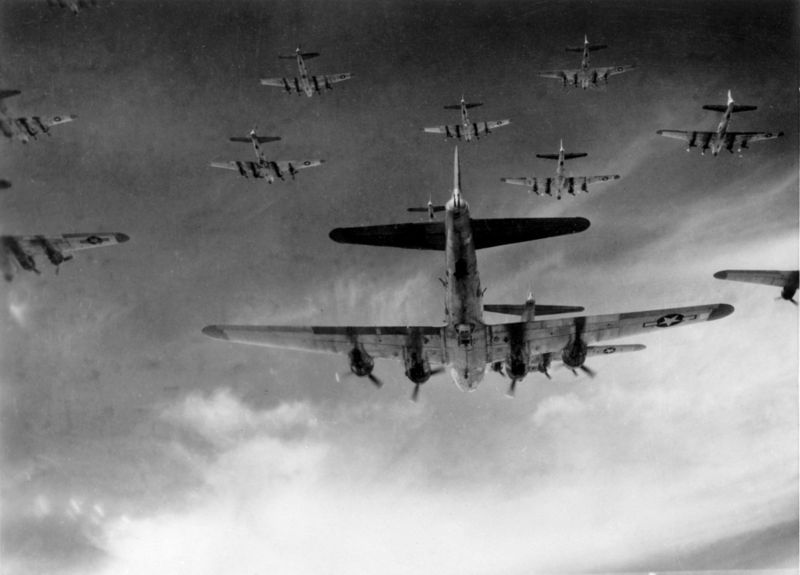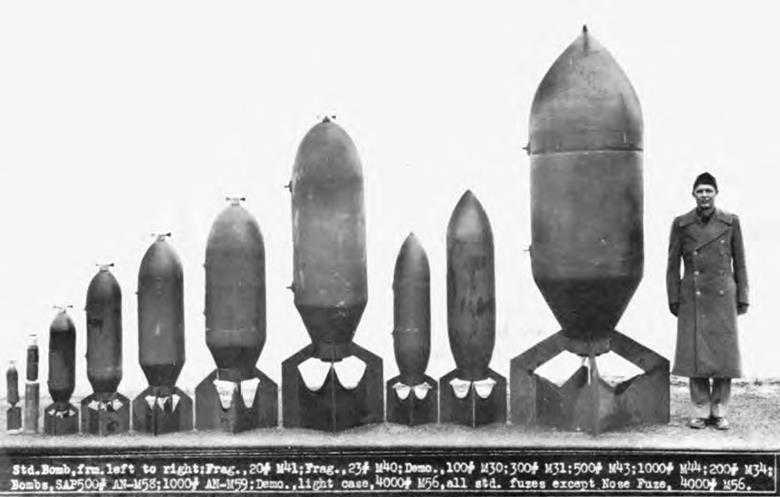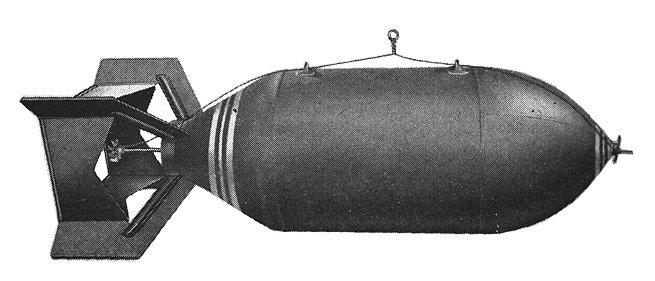Introduction
During World War II, aircraft were equipped with bombs to attack ground targets. Ground attack aircraft (fighter-bombers) and bombers were particularly suitable for carrying bombs and the US Air Force used different types of aircraft for that purpose. The American B-17 (Boeing B-17 Flying Fortress) was very suitable for carrying heavier (conventional) bombload. Some bombs were relatively light and weighed around a hundred kilograms, whereas other bombs weighed more than a ton. The most powerful American conventional bombs could flatten entire residential areas. Because covering all types of bombs goes too far (incendiary bombs, armoured bombs, fragmentation bombs, poison gas bombs, etc.), this article aims to provide an overview of the most important American conventional, explosive bombs that were used against German and Japanese targets between 1942 and 1945.
Definitielijst
- Flying Fortress
- Nickname for the Boeing B-17 heavy bomber, because of its heavy defensive armament.
Various types
The standard bombs ('GP', 'General Purpose') of the US Air Force were the AN-M30, the M31, the M43 and the M34. The M34 was a heavy bomb weighing 907.18 kg and used against industrial targets, just like the M43 (226.8 kg) and the M44 (453.6 kg) bombs. The lighter bombs (AN-M30 and M31) were mainly used against airfields. All bombs mentioned had explosive contents. The M43 and M34 were also used against concrete fortifications, where German submarines were docked, but had relatively little effect due to the absence of armour-piercing heads.
Bomb fuses were often exposed to damp conditions on the airfields overnight, which could lead to the fuses being frozen up during the flight resulting in bombs’ failure to explode. Remedial actions were taken by instructing to only insert the fuses shortly before take-off; also as a general safety precaution.
From 1943 onwards new types of bombs were produced such as the AN-M57, the AN-M64, the AN-M65 and the AN-M66. The AN-M65 (weighing 437.72 to 449.05 kg) and the AN-M66 (907.18 to 951.86 kg) were very heavy bombs. The second heaviest American conventional bomb produced in reasonably large numbers was the AN-M56, weighing approximately 1.8 tons (4000 lbs). So-called ‘Pumpkin bombs’, conventional bombs that closely resembled the 'Fat Man' nuclear bomb and used for training purposes, were sometimes also used against Japanese cities. These 'Pumpkin bombs' were produced in relatively small numbers and were the heaviest American conventional bombs.
AN-M30
The AN-M30 was a light-weight bomb of49.9 to 52.16 kg with an explosive content of 24.49 kg of Amatol or 25.85 kg of TNT. An AN-M30A1 version also existed. The bomb measured 91.44 cm in length with a diameter of 20.83 cm. The casing was 0.41 cm thick. The fuses were often of the AN-M103 type (all suitable fuses were the AN-M103, AN-M103A1, M135, M135A1, M136, M136A1, M139, AN-M139A1, AN-M140A1, M140, M140A1, M149, M163, M164, M165, Mk 239, Mk 243-0 and Mk 244-0). The bomb was mainly used against targets such as railway yards, small buildings, ammunition depots, aircraft on the ground and hangars. The bomb had an olive drab colour with a yellow band around the nose and tail.
Definitielijst
- TNT
- Trinitrotoluene. Explosive. Mainly used in bombs and heavier hand grenades.
AN-M57
The AN-M57 was a relatively light-weight bomb of 113.4 to 117.93 kilograms with an explosive content of 56.11 kg of Amatol to 58.51 kg of TNT. An AN-M57A1 version also existed. The bomb was 115.32 cm long with a diameter of 27.68 cm. The casing was 0.69 cm thick. The fuses used were often of the AN-M103 type (all versions were the AN-M103, AN-M103A1, M103, M135, M135A1, M136, M136A1, AN-M139A1, M140, AN-M140A1, M149, M163, M164, M165, Mk 239, Mk 243, Mk 244 and M148). The bomb was mainly used against railways, ammunition depots, destroyers, submarines and transport ships. The bomb had an olive drab colour with a yellow band around the nose and tail.
Definitielijst
- TNT
- Trinitrotoluene. Explosive. Mainly used in bombs and heavier hand grenades.
AN-M64
The AN-M64 was a medium-sized bomb of 226.8 to 242.67 kg with an explosive content (usually TNT or Amatol) of 118.9 to 124.28 kg (121.11 kg occurred in bombs with TNT content). There was also an AN-M64A1 bomb version filled with TNT or Composition B. The AN-M64 bomb measured 144.27 to 144.78 cm in length with a diameter of 36.07 cm. The casing was 0.762 cm thick. The fuses were often of the AN-M103 type (all suitable fuses were the AN-M103, M103, AN-M103A1, M135, M135A1, M136, M136A1, M139, AN-M139A1, M140, AN-M140A1, M149, M163, M165, Mk243, Mk244, Mk239 and the AN-Mk219). The bomb was mainly used against steel railway bridges, tunnels, concrete docks and light cruisers. The bomb had an olive drab colour with a yellow band around the nose and tail.
Definitielijst
- TNT
- Trinitrotoluene. Explosive. Mainly used in bombs and heavier hand grenades.
AN-M65
The AN-M65 was a heavy bomb weighing 437.72 to 449.05 kg with an explosive content of 240.4 kg of Amatol to 253.10 of TNT. The bomb measured 170.43 cm in length with a diameter of 47.75 cm, whereas the casing was 1.27 cm thick. The fuses were often of the AN-M103 type (all suitable fuses were the AN-M103, M103, AN-M103A1, M135, M135A1, M136, M136A1, M139, AN-M139A1, M140, AN-M140A1, M149, M163, M164, M165, Mk 239, Mk 243 and Mk 244). A second type of bomb, the AN-M65A1, was also produced. The bomb was mainly used against concrete bridges, steel bridges, piers and medium cruisers. The bomb had an olive drab colour with a yellow band around the nose and tail.
Definitielijst
- TNT
- Trinitrotoluene. Explosive. Mainly used in bombs and heavier hand grenades.
AN-M66
The AN-M66 was a heavy bomb weighing 907.18 to 951.86 kilograms with an explosive content of 482.17 (Amatol) to 506.66 kilograms (TNT). It measured 182.37 to 229.61 cm in length and had a diameter of 59.18 cm. The fuses were usually of the AN-M103 type (all suitable fuses were the AN-M103, AN-M103A1, M103, M135, M135A1, M136, M136A1, M139, AN-M139A1, M140, AN-M140A1, M149, M163, M164, M165, Mk243, Mk244 and the Mk239). Tail fuses consisted of the AN-M102A2, AN-M102A1, M102 and M162. Other versions of the bomb were the AN-M66A1 and AN-M66A2. The bomb was mainly used against reinforced concrete, heavy cruisers, battleships and dams. The bomb had an olive drab colour with a yellow band around the nose and tail.
Definitielijst
- TNT
- Trinitrotoluene. Explosive. Mainly used in bombs and heavier hand grenades.
AN-M56 (Blockbuster)
The AN-M56 was the US Air Force's heaviest conventional bomb that could be carried on the B-17 aircraft. The bomb weighed 1,852.92 to 1,907.35 kg with an explosive content of 1,471.91 kg of Amatol to 1,524.98 kg of TNT. The bomb measured 297.94 cm in length with a diameter of 86.36 cm. The casing was 0.94 cm thick. Suitable fuses were the AN-M103A1, AN-M103, M103, M135, M135A1, M136, M136A1, M139, AN-M139A1, M140, AN-M140A1, M149, M163, M164, M165, Mk239 and AN-Mk219. The tail fuse of the bomb was either an AN-M102A2, AN-M102A1 or M162 fuse. The bomb was powerful enough to flatten an entire residential area, hence its nickname Blockbuster.
Definitielijst
- TNT
- Trinitrotoluene. Explosive. Mainly used in bombs and heavier hand grenades.
Pumpkin bomb
The 'Pumpkin bomb' was a test or training bomb, developed as part of the Manhattan Project (development and deployment of the atomic bomb). In fact, the bomb was a replica of the 'Fat Man' plutonium bomb, which was to be dropped over Nagasaki on August 9, 1945. The 509th Composite Group, responsible for testing nuclear weapons, used the conventional pumpkin bomb against Japanese cities. A total of 49 of those bombs were dropped on 14 targets. The replicas of 'Fat Man' weighed 5.34 tons and had an explosive content of 2,900 kg. The bomb measured 3.25 meters in length with a diameter of 152 cm. The bombs were carried exclusively by the B-29 (Superfortress) bomber.
Definitielijst
- Manhattan Project
- The American development of the Atomic bomb during World War Two.
- Nagasaki
- Japanese city on which the United States dropped the second atomic bomb on 9 August 1945.
Comparison with other countries
The American AN-M56 was about as powerful in terms of explosive content as one of the heaviest German bombs (SC 1800 'Satan' and SC 2000), but less powerful than the approximately two and a half ton SC 2500 'Max'. Only the British and the Soviets had heavier and more powerful conventional bombs. The British had the ten-ton 'Grand Slam' bomb (a bomb capable to cause an earthquake), and the Soviets disposed of the five-ton FAB-5000/FAB 5000NG which was first dropped on fortifications in Königsberg on 28 April 1943 and later also on railroad tracks during the Battle of Kursk in July 1943.
Information
- Article by:
- Ruben Krutzen
- Translated by:
- Simon van der Meulen
- Published on:
- 22-02-2025
- Feedback?
- Send it!






